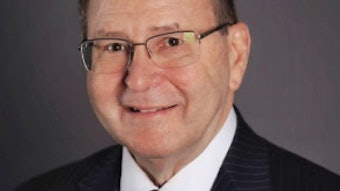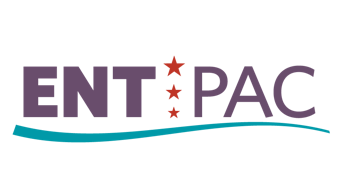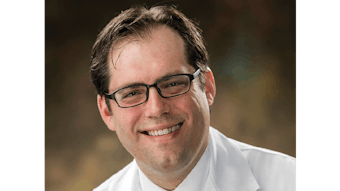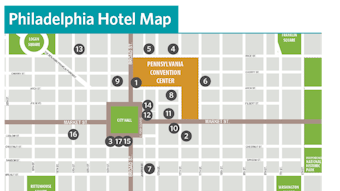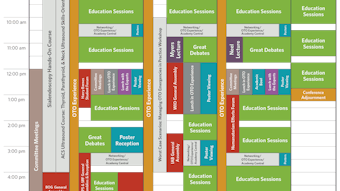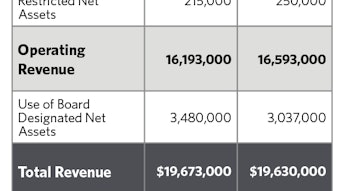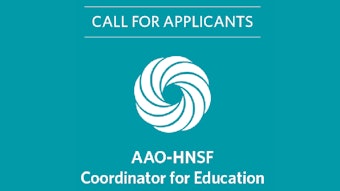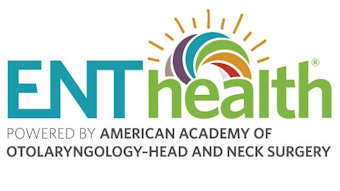FROM THE EDUCATION COMMITTEES: The Trouble with Temporomandibular Dysfunction
More than 5% of the population is thought to be affected by temporomandibular disorders (TMD).
Cristina Cabrera-Muffly, MD, Chair-elect, General Otolaryngology and Sleep Education Committee
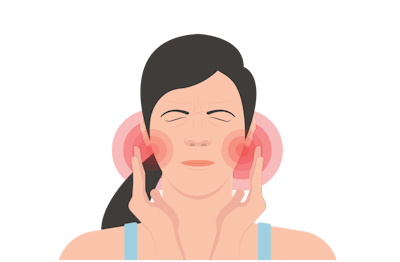
One of the first descriptions of the relationship of ear, jaw, and sinus pain attributed to the temporomandibular joint was published by Costen in his 1934 paper in Annals of Otology, Rhinology, and Laryngology. While Costen incorrectly attributed all the symptoms to malocclusion of the temporomandibular joint, he did understand the concept of referred pain’s role in TMD.1 Although aspects of the diagnosis and treatment of TMD remain controversial, researchers have developed useful algorithms for patients with TMD who present to the otolaryngologist.
Most patients with TMD present with some combination of otalgia or facial pain, ear fullness, and tinnitus.2 While the prevalence of these symptoms vary between studies, more than 50% of patients in all studies present with the above. Less commonly, patients report vertigo, hearing loss, trismus, or displacement of the joint. The most common exam finding is masticatory muscle tenderness.3 Turning to our dental and oro-maxillofacial colleagues, the International Research Diagnostic Criteria TMD Consortium Network developed a commonly used classification tool differentiating TMD into four categories, including TMJ anatomical dysfunction, masticatory muscle disorders, headache disorders, and problems with associated structures. Patients can have diagnoses from more than one category.4
Symptoms of temporomandibular joint (TMJ) anatomical dysfunction—pain over the joint, popping, locking, and limited range of motion—should be treated differently than masticatory muscle disorders, which typically present with facial pain, muscle point tenderness, and otolaryngological symptoms in the absence of any anatomical pathology.5 The Consortium Network also implements assessment of TMD to include two axes. The axes divide TMD into physical dysfunction (Axis I) and the psychological impact of the disorder (Axis II), both of which are significant in determining appropriate therapeutic options.4
Common sensory innervation via the auriculotemporal nerve can make it difficult to differentiate between primary and secondary (referred) otalgia. Therefore, eliciting associated symptoms and a comprehensive physical exam of the head and neck are critical to rule out other disorders, such as primary ear disorders, neoplasia, sinus disorders, temporal arteritis, trigeminal neuralgia, cervical spine disease, or even cardiac disease. Patients with hearing loss or tinnitus should be worked up with an audiogram. Consider vestibular testing in patients with otherwise unexplained vertigo. In cases of otalgia in the absence of classic TMJ pathology or muscle tenderness, nasopharyngoscopy and laryngoscopy should be used to rule out infectious or malignant causes of referred pain.6 Consider imaging in patients with concurrent nasal symptoms if red flag symptoms such as cranial neuropathy are present, when conservative treatment strategies are not effective, or if symptoms worsen despite treatment.1 If cardiac, rheumatologic, or spinal disease is suspected, referral to the appropriate specialist is warranted. Remember to screen for sleep apnea since bruxism and apnea are correlated.
Once the diagnosis of TMD has been confirmed, the patient should be counseled on conservative treatment strategies. These include warm or cool compresses, massage, soft diet, and gentle stretching exercises. Pharmacotherapy can be used as a short- or long-term adjunct, including non-steroidal anti-inflammatory drugs, muscle relaxants, neuromodulators, or tricyclic antidepressants.3 Referral to a dentist or oral surgeon who can make a custom splint can be helpful, although a Cochran review found insufficient evidence for splinting.7 Patients with TMJ anatomical dysfunction will also benefit from referral to an oral surgeon to discuss treatment options specific to the joint. If first-line conservative treatment is not sufficient, other treatment options include physical therapy, electrical stimulation, acupuncture, dry needling, or trigger point injections with steroids or botulinum.7 Many of these treatments can be performed by a physical therapist, although it may be necessary to involve an orofacial pain management specialist.
Many patients seek care from otolaryngologists for TMD-related symptoms, and our specialty is frequently the first line for assessment of these disorders. The skilled otolaryngologist must rule out more concerning diagnoses, verify that the TMD diagnosis is correct, and educate the patient on both the cause and treatment options for their symptoms.
References
1. Israel HA, Davila LJ. The essential role of the otolaryngologist in the diagnosis and management of temporomandibular joint and chronic oral, head, and facial pain disorders. Otolaryngol Clin North Am. 2014 Apr;47(2):301-31. doi: 10.1016/j.otc.2013.12.001.
2. Porto De Toledo I, Stefani FM, Porporatti AL, et al. Prevalence of otologic signs and symptoms in adult patients with temporomandibular disorders: a systematic review and meta-analysis. Clin Oral Investig. 2017 Mar;21(2):597-605. doi: 10.1007/s00784-016-1926-9.
3. De Rossi SS, Greenberg MS, Liu F, Steinkeler A. Temporomandibular disorders: evaluation and management. Med Clin North Am. 2014 Nov;98(6):1353-84. doi: 10.1016/j.mcna.2014.08.009.
4. Schiffman E, Ohrbach R, Truelove E, et al., International RDC/TMD Consortium Network, International association for Dental Research; Orofacial Pain Special Interest Group, International Association for the Study of Pain. Diagnostic Criteria for Temporomandibular Disorders (DC/TMD) for Clinical and Research Applications: recommendations of the International RDC/TMD Consortium Network* and Orofacial Pain Special Interest Group†. J Oral Facial Pain Headache. 2014 Winter;28(1):6-27. doi: 10.11607/jop.1151.
5. Stepan L, Shaw CL, Oue S. Temporomandibular disorder in otolaryngology: systematic review. J Laryngol Otol. 2017 Jan;131(S1):S50-S56. doi: 10.1017/S0022215116009191.
6. Hwa TP, Brant JA. Evaluation and Management of Otalgia. Med Clin North Am. 2021 Sep;105(5):813-826. doi: 10.1016/j.mcna.2021.05.004.
7. Lee E, Crowder HR, Tummala N, Goodman JF, Abbott J, Zapanta PE. Temporomandibular disorder treatment algorithm for otolaryngologists. Am J Otolaryngol. 2021 Nov-Dec;42(6):103155. doi: 10.1016/j.amjoto.2021.103155.
